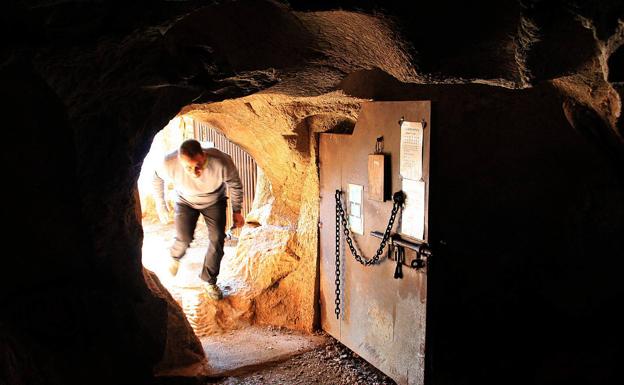

Sections
Highlight

FERGAL MACERLEAN
MALAGA.
Monday, 7 November 2022
Explore Malaga province's rich cave heritage: there are 20 or so limestone caves here, a dozen of which harbour important works of prehistoric rock art. While some are only accessible to experienced cavers, several are open to the public and are ideal for a visit on a blazingly hot or rainy day.
The most famous of these is the Nerja Cave. And with good reason, as a visit is quite special. The site is located four kilometres east of town by the pretty, traditional village of Maro.
Stairs lead down into the cool air and then, all of a sudden, you have the vast cave ahead of you. Everywhere you look there are weird and wonderful formations such as calcite curtains, coloured by metallic minerals to appear blue, green, coppery red, or a striking white.
A smooth path leads in a loop through the cavern passing an enormously thick 32-metre high pillar. The 45-minute tour which is made with a guide or audio device (in English) explores much of the gallery. Two other galleries are closed to the public. Cave art in these was previously considered of Neanderthal origin though doubt was cast on this in 2020 after a re-assessment by the original team of their dating techniques.

However, ancient paint markings at a cave close to Ardales, north of Malaga, were in 2021 found to date back almost 65,000 years when modern humans did not inhabit the continent. Archaeological surveys have conclusively linked the more than a thousand painted or engraved motifs found here to Neanderthals. Researchers say the series of pre-figurative graphic codes that are represented there, and at other Malaga caves, are the forerunner of the figurative art that spread throughout Europe and part of Asia and Africa.
The large, 1.6-kilometre long Ardales cave, and adjacent prehistory museum, can be visited as part of a pre-booked three-hour guided trip (in Spanish) suitable for able-bodied visitors aged between eight and 70. One can see the red ochre marks on stalagmites attributed to our ancient cousins, the Neanderthals, which scientists say were applied by hand, using splattering or blowing techniques. These are among the oldest cave markings in the world.

Easier to appreciate is the big black deer painting, located in a deep gallery, which is between 14,000 and 30,000 years old. Painted in black it has a thick red mark denoting the animal's heart. Also fascinating in Ardales are the incredibly fresh-looking airbrushed hands created by someone more than 35,000 years ago blowing paint on their outstretched fingers. And there are multicoloured paintings of deer, goats and fish. Some of the paintings are accessed by climbing up steps inside the five-chamber cave which is not for those with vertigo.
Closer to Malaga, in Rincón de la Victoria, there are two caves which can be visited. The more accessible one is the Treasure Cave (La Cueva del Tesoro) which, with its atmospheric lighting and underground pools, is ideal for a family visit. An audio guide (available in English) details how remains from the Paleolithic and the Bronze Age were found there, as well as Paleolithic art. According to legend, the cave houses treasures belonging to Berber kings from the Sahara who ruled over Al-Andalus - the Muslim-controlled area of the Iberian Peninsula - until they were overthrown by Muslim rivals in 1147.
Noticia Relacionada
The Victory Cave (La Cueva de la Victoria) is located close by and has two kilometres of galleries with paintings and engravings from the upper Palaeolithic and Neolithic periods, as well as a large prehistoric archaeological site. It opened to the public for the first time in February and can be visited as part of a pre-booked guided tour for those aged over ten and under 70 years old. Helmets and headlamps are provided for the two-hour exploration.
Another Malaga cave famed for its prehistoric rock art is the Cueva de la Pileta, south-west of Ronda, near Benaoján. Guided hour-long tours are available which children as young as five can enjoy. The experience of entering the privately owned cave from the thyme-scented roadside is exciting. And as you make your way through the relatively warm series of galleries it feels like you are one of the first explorers of this cavern which reaches a maximum height of 15 metres.

This was a dwelling and burial place and contains paintings that are between 10,000 and 30,000 years old. Most of them represent animals with goats being the most prevalent, although there are also horses, buffaloes, bison, and a strikingly good deer.
The paintings have been grouped together according to the techniques used to create them. The oldest style is considered to have been made by daubing mud with fingers and includes the unmistakable outline of a fish.

Publicidad
Publicidad
Publicidad
Publicidad
Esta funcionalidad es exclusiva para registrados.
Reporta un error en esta noticia

Debido a un error no hemos podido dar de alta tu suscripción.
Por favor, ponte en contacto con Atención al Cliente.

¡Bienvenido a SURINENGLISH!

Tu suscripción con Google se ha realizado correctamente, pero ya tenías otra suscripción activa en SURINENGLISH.
Déjanos tus datos y nos pondremos en contacto contigo para analizar tu caso

¡Tu suscripción con Google se ha realizado correctamente!
La compra se ha asociado al siguiente email
Comentar es una ventaja exclusiva para registrados
¿Ya eres registrado?
Inicia sesiónNecesitas ser suscriptor para poder votar.